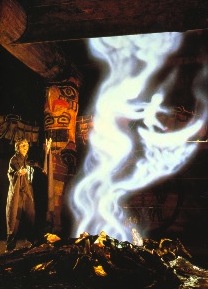Tuesday, April 29, 1986.
BENEATH THE SMOKE HOLE, in the glow of the fire pit, an old man remembers the days of his youth. As he speaks, he gestures and, because he is a magician, his gestures call forth images in the smoke of The Spirit Lodge.
The storyteller is an actor who appears live on stage to recall legends of the Kwakiutl people. He raises spirits with the help of a new environmental projection system called Holovision, a process that creates apparently solid images in the air, a motion picture without a screen.
"People who see it think it's holography," says Bob Rogers, the creator of this unique imaging system. "Well, it's not."
A process first demonstrated in a General Motors-sponsored show called Wizard of Change at the Chicago and Los Angeles museums of science and industry, Holovision achieves its effect by other means.
Because people insist that it must be a holographic process, he registered the name Holovision — "a neat gimmick word'' — as his trademark.
Because patents are currently pending, Rogers is reluctant to discuss it in detail. Although he allows that "the images are stored on 70mm film," and that the shape of G.M.'s Expo 86 pavilion is governed by the needs of his process, he stops short of explaining away the illusion.
Because the system is "really expensive,'' Rogers sees few applications for it outside of special expositional situations. "Come and see it (at Expo 86)," he says.
"It won't be coming to your local drive-in."
In the case of The Spirit Lodge, an eight-minute introduction to Pacific Northwest native culture, the technology is in the service of its subject, Rogers stresses. Developed in consultation with various B.C. clan groups, the show is Expo's only major attraction devoted to Canada's indigenous peoples.
As for actual holography — the laser light photographic process that produces three-dimensional pictures — Expo visitors need look no further than The Roundhouse. An art show called The Spectral Image, it offers an "integrated exhibition of holography, photography, sculpture, light and sound" organized by Canadian experimental film-maker Michael Snow.
The above is a restored version of a Province Expo 86 preview feature by Michael Walsh originally published in 1986. For additional information on this archived material, please visit my FAQ.
Afterword: "Pepper's Ghost," said Dr. Hutchings with total assurance. "It's an old stage magician's trick." A long-time family friend, John Edward Hutchings had been a math professor, a computer programmer, a symphony musician and, at one point, was close to Toronto's community of professional stage magicians. He identified the "secret" of Holovision, telling me that it was a bit of stage magic with a long history. First described by the Italian polymath Giambattista della Porte in his 1558 treatise Magia Naturalis (Natural Magic), the modern version is named for English chemist John Henry Pepper, who famously demonstrated the effect in an 1862 London performance of The Haunted Man (an adaptation of a Charles Dickens novella). In the classic version, audience members are shown a room in which spectral images appear, disappear and even transform into other forms, as if by magic.
What the audience doesn't know is that there is a second, hidden room, a mirror image of the one they can see, and that it contains the "ghost" performers. There is an invisible (to the audience) glass wall at a 45° angle separating the two. Raising the lights in the hidden room causes the images to be reflected on the glass, creating the illusion of things suddenly appearing in the room the audience sees. When The Haunted Mansion opened in Disneyland in 1969, it offered the California theme park's visitors the world's largest example of a Pepper's Ghost illusion. It's no coincidence that Holovision creator Bob Rogers's entertainment industry resume begins in 1968 with a job as a magician in Disneyland's Main Street Magic Shop.
When I interviewed him for the above Expo 86 preview story, Rogers said that the process used in Spirit Lodge was not holography. With a fine magician's use of misdirection, he noted that the glass wall separating audience members from the show's live shaman was there to protect them from the smoke effects. Despite an explanation that was pure smoke and mirrors, the effect was enchanting, and provided a show that was among the fair's most memorable. In 1994, Spirit Lodge was recreated as Mystery Lodge at the Knott's Berry Farm theme park in Buena Park, California, where it remains a popular attraction to this day (2016). Rogers, who founded his own company, BRC Imagination Arts in 1981, continues to create special-venue entertainments for theme parks and world's fairs. He's picked up numerous honours and awards along the way, including two Oscar nominations. Rogers was elected to the Board of Governors of the Academy of Motion Picture Arts and Sciences in 2014, where he currently represents the organization's Short Films and Feature Animation Branch.
See also: The 13 articles included in this, the first of four Expo 86 special reports, are:
